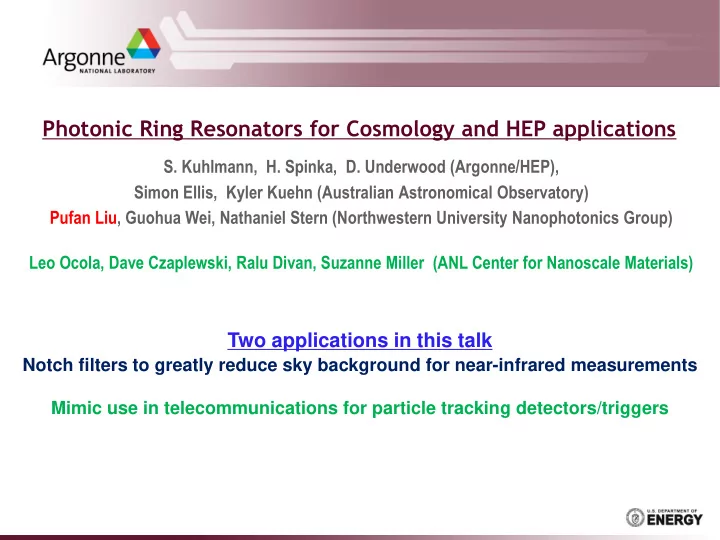

Photonic Ring Resonators for Cosmology and HEP applications S. Kuhlmann, H. Spinka, D. Underwood (Argonne/HEP), Simon Ellis, Kyler Kuehn (Australian Astronomical Observatory) Pufan Liu, Guohua Wei, Nathaniel Stern (Northwestern University Nanophotonics Group) Leo Ocola, Dave Czaplewski, Ralu Divan, Suzanne Miller (ANL Center for Nanoscale Materials) Two applications in this talk Notch filters to greatly reduce sky background for near-infrared measurements Mimic use in telecommunications for particle tracking detectors/triggers
Optical/Infrared Silicon Waveguides (<1um wide/tall) Difference in index of refraction of silicon with surrounding material Design file with 32 Our test-stand, optical fiber input and independent devices output, tunable and fixed red and IR lasers 10um Ring in middle (SEM pic) 2
Optical Ring Resonators: Resonant cavities on a chip St. Paul’s Cathedral, London The Whispering Gallery
How do Ring Resonators Work? 25um single SiN ring with different modes (7nm gaps) Silicon ring and waveguides fabricated at Argonne SEM pic: 3um scale 4
Nanofabrication Steps With UV Lithography (<100nm process) or more precise Electron Beam Lithography Start with 3-layer wafer: a) Si substrate, b) SiO2, c) Silicon device layer Entire process ~6 hours total, <$200/wafer Many different materials used, not just silicon 5
Cascaded ring resonators as multi-notch filters Revolutionize Infrared Astrophysics by removing sky background spikes Even with only 6 notches over 60nm window, can improve SNR from 1 to 5 Need a series of rings on a single waveguide, each with a different radius, tuned to the sky background wavelengths 6
Optical ring resonators for Cosmology What is the Science? – All ground-based near-infrared probes of cosmic acceleration • Supernovae – Redshift>1 SNe smothered by sky lines – All redshift SNe near-infrared insensitive to dust, may be dominant systematic for LSST – Redshift<1 SNe near-infrared provides much better standard candle with no corrections – Game-changer for ground-based supernova science, only hope for 100% LSST NIR follow-up • Galaxies redshift>1 – Southern Spectroscopic Instrument being discusses – New $10-$100M instrument to follow-up and enhance LSST /DESI/CMBS4 – Focus on pushing into near-infrared for almost all options – OH sky background increases costs, limits wavelength ranges, and degrades performance without suppression technology • Reionization galaxies redshift>7 – New thirty-meter telescopes Proposed DESI upgrade is a 4 th NIR arm (D. Schlegel) 7
Detailed Specifications and Early Test Results in Recent Pub. 8
Specs for a science-ready, ring-resonator notch-filter chip 1. Free spectral range > 30nm (FSR, gaps between resonator modes) 2. Notch width < 0.4nm 3. Polarization-independent enough to not ruin other specs 4. Notch depth > 20dB 5. >5 notches per chip at correct wavelengths 6. Transmission enough to significantly improve signal-to-noise (~50%) = Specs currently satisfied
Last 5 wafers produced ~90% yield good devices
Summary plot of Free Spectral Range (FSR, gaps between modes)
Silicon photonics emerging technology in telecommunication and computing First major US silicon photonics foundry opened last year in Rochester $610M facility, $500M industry, $110M DOE and DOD IBM 2012 press release: “Silicon Nanophotonics is Ready for Development of Commercial Applications” Typically using voltage modulation of ring wavelengths 12
Example of Ring Resonator Wavelength Modulation Gardes et al., 2009 13
Stojanovic (MIT) 14
Integrated pixel detector/pre-amp and ring resonator chip 1 Ring illuminated with CW laser/LED, 1 PIXEL Voltage changes output wavelength, measured off the detector to give a “hit” • Low Mass: Integrated with pre-amp, possibly nothing else on detector • Low power ~1uW/channel (Pradhan et al., 2005) • Compact: ~5um/channel (ring diameter + light wavelength) • Fast: >165 GHz (Bortnik et al., 2007) • Modulation with rad-hard pn diode 15
Summary Silicon Photonics an Emerging Technology, new to US HEP Possible high-impact applications in cosmology and HEP TDAQ Notch filters for background removal in near-infrared cosmology measurements under development Technologies and techniques similar for all applications 16
Recommend
More recommend